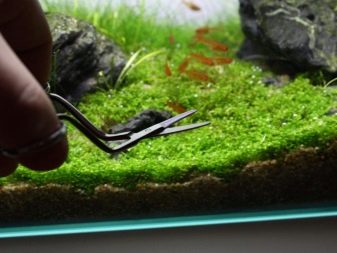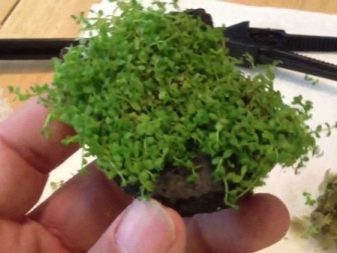The aquarium, without a doubt, is a real decoration of any home. At the same time, everyone prefers his own design style of this miniature pond: someone likes minimalism, which is characterized by a complete lack of vegetation, a rocky bottom and shards with figurines, and someone prefers complete landscaping. It is for them that chemianthus is suitable - a herbaceous perennial that lives in water and is universally used for decorating aquariums. Some experts also call this plant a mikrantemum.


Description
Hemianthus belong to the plantain family, but it has nothing to do with the well-known plantain. In the natural environment, it is found near marshy places and on the banks of small rivers of tropical and subtropical zones. The micrantemum grows 15 cm wide. The plant is distinguished by the following symptoms:
- elongated creeping roots forming a large number of filiform roots;
- branched stems - their thickness is 0.4-0.6 cm;
- rounded sheet plates;
- small flowers located in the first pair of leaf sinuses, which usually bloom in the winter months.

Varieties
There are several main varieties, among them chemianthus mikrantemoides, dwarf and other subspecies. Some of them are more common among aquarists.
Shade Micrantemum
A representative of this subspecies lives in the marshlands of North and South America. This plant can be recognized by rather small leaves, the diameter of which does not even reach 1 cm.In its natural habitat, it exists above and under water and grows up to 15 cm wide and 20 cm long.
Shady micrantemum is ideal for aquariums of any volume, but it looks best in tanks of 100 l or more. Usually this plant is planted in the middle or foreground, rooting with a dense synthetic thread between stones and snags. This plant makes up a harmonious tandem with Javanese moss and fern. If you create conditions that are comfortable for him, then it grows quite quickly, becomes lush, and the color becomes saturated. The plant requires:
- water temperature in the range from 21 to 27 °;
- acidity from 5 to 8 units;
- stiffness not exceeding 9;
- at least 8-hour lighting (both natural and artificial are allowed, it is best to use fluorescent lamps with a power of 0.7 W / l);
- loose silted (but not acidified) substrate;
- regular foliar top dressing;
- carbon dioxide concentration not exceeding 10 mg / l: if this parameter is higher, the leaves will become small and inconspicuous;
- regular haircuts, which contributes to greater splendor.

Monte Carlo
This plant was discovered in 2010 in Argentina. Monte Carlo is usually planted in the foreground in an aquarium. This plant is ideal for creating a stylish, beautiful and diverse aqua design. It should be noted that for aquarists this is a relatively new variety, so there is little information about the conditions of its maintenance. Nevertheless, some nuances are known. In particular, for the full growth and development of this variety of green aquatic inhabitants, you need:
- well-filtered water: if the plant is covered with algae, it begins to wither and dies;
- low light: use of 0.5 W / l lamps is allowed.
To maintain the health of leaves and roots, they need regular top-dressing with iron-containing preparations, otherwise the leaves begin to turn yellow and fall off. Keep in mind, if you notice that the leaves are blackened - it means that you "overfeed" them. In this case, top dressing should be stopped for a while. Plant Features:
- it does not matter the concentration of carbon dioxide;
- fine-grained soil is desirable;
- water temperature should be between 22–28 °;
- allowable stiffness indicator 5–19;
- acidity should be determined within 5 units.
It is also noted that plants feel much better if there is a weak electric current in the pond. Every 5-7 days it is necessary to renew the water by a third.

Low flowered
This type of micrantemum grows in shallow lakes and ponds of the eastern part of the North American continent. The little-flowered micrantemum has erect stems, which are sufficiently elongated and divorced to the sides. These bushes grow up to 25-30 cm. The leaves have a pronounced light green hue, are located 3-4 in whorls, no cuttings. The leaf is oblong, the tip is obtuse, the width of the base is small: about 3 mm, and the length of the plate does not exceed 1 cm. The roots are rather weak, creeping along the bottom.
This variety is considered the most unpretentious, since its successful content requires the observance of the most elementary conditions:
- small tanks with a volume of 25-30l;
- acidity within 5–9 units;
- water hardness at the level of 13-14;
- temperature in a rather large range: from 16 to 29 °, due to such unpretentiousness, the plant does not suffer even in the cool season;
- bright lighting (from 1.7 W / l) and at least 4-hour daylight;
- water the plant needs clean, well filtered, it is advisable to replace it every week with 20-25%;
- soil should be regularly fed, it is best to use blue clay.
If these rules are observed, then the little-flowered micrantemum grows very quickly, adding up to 10 cm every month.
Since this species spreads on the ground, in the creation of an aquarium it is most often used for spawning: in its dense vegetation, the females hide their eggs, and then the hatched fry.

What to do after purchase?
Before buying, chemanthus should be examined as thoroughly as possible on all sides in order to make sure that there are no algae on the leaves. The fact is that they tend to grow very quickly and are capable of destroying all aquarium vegetation. If you haven’t done this and found algae already at home, be sure to rinse your green pet well in running water at room temperature. Each bush must be placed on a specially designated area for it. If the plant turned out to be more voluminous than you expected, just divide it into several parts and plant it, there is no need to root it.
Before planting, it is advisable to put a small piece of clay in the soil or a suitable fertilizer: they contain trace elements necessary to maintain the full growth and health of the plant. It is better to choose a well-lit place for a hemanthus, so the background is not suitable for him. It is best to plant it in the front zone, and use special aquarium fluorescent lamps for lighting. In daylight, natural light is allowed.
Keep in mind: the plant will grow very quickly. You can either allow him to do this, and then in the very near future you will receive a spectacular green carpet, or you will conduct regular pruning, which will help maintain the decorativeness of the bush.


Growing conditions
Hemianthus is able to adapt to existence in any aquarium, but it is believed that the containers with a volume of 70 l or more are most optimal for it, since it will be much easier to mow them in a rapidly growing lawn. In small aquariums, it simply drowns out all other plants, and it looks much more organic when it is located in spacious containers, without interfering with admiring other inhabitants of the aquatic microworld. The plant reacts best to warm water (25–28 °), non-rigid (up to 6) and non-acidic (6–7 units). Lighting should be long. But to make the foliage thicker and brighter, it is desirable that the light is indirect, but slightly muffled or diffused. Moreover, it does not matter whether it is natural or artificial.
To ensure magnificent growth, you should occasionally feed the plant with a complex of fertilizers. If this is not done, then the leaves begin to turn yellow and fade very quickly. Do not forget about the constant filtration of water and its periodic renewal: these manipulations have the most beneficial effect on the development of chemanthus. Otherwise, the leaves quickly become covered with algae, which at best will hide the beauty of the plant, and at worst will destroy it.
If you notice that your pet’s castings are crushed or completely stopped growing, then, most likely, the conditions for keeping plants are violated. Recheck each indicator and if any deviations are found, immediately take measures to correct the situation:
- if the temperature has dropped, it must be raised to the optimum level;
- if acidity has decreased or increased, respectively, increase or decrease it.
If all the parameters are within the standards, then perhaps your problems will be solved after a partial renewal of water. Unfortunately, chemanthus is still little studied by scientists, so aquarists often have to solve most of the problems by trial and error.


Breeding
Hemianthus reproduces very simply: trimmed tops, shoots and roots. All that is required of you is simply to place them in the same substrate and put blue clay under it. This measure promotes rapid rooting and good survival of the plant.However, when creating comfortable living conditions, a young hemianthus can take root without fertilizing.
You need to plant the plant in separate branches very carefully with tweezers, each in a separate hole. It is allowed to lightly crush it with a pebble for a while, so that the bush does not pop up until it is completely rooted.


Diseases and Pests
Hemianthus is a rather fragile plant, which is why dangers await him literally at every step. Snails, herbivorous fish, and algae can be fatal to him. Most often, an aquarium resident is the victim of fast-growing algae. As they grow, they literally entangle the bush and injure its leaves. This often leads to the death of the plant. To avoid such a nuisance, you should change the water as often as possible and avoid too bright lighting.
Regardless of what the environment is like in your aquarium, the first time after planting a hemianthus, you need to monitor its condition. And if you notice that something is going wrong - change the conditions of detention, then continue to observe.
If cichlids, barbs and snails live in your artificial reservoir, it is better to get other green inhabitants, and a separate aquarium should be allocated to the hematanthus whose inhabitants do not belong to herbivorous creatures.


See how to properly cut hemianthus mikrantemoides in the next video.










